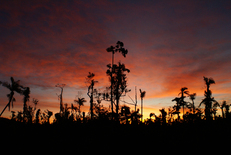
The impact has been quite different from cyclone Larry. Before Yasi, the rejuvenating rainforest was beginning to provide some shade cover but was still very light and open in many places with lots of pioneer species creating an understorey. This time with many of the oldest and largest canopy trees gone, the saplings and younger trees are experiencing an enormous growth spurt and are providing enough shade to sufficiently inhibit the pioneer species and many of the weeds that proliferated post Larry. They are the species that will in time form part of the next canopy. We may have a jagged skyline with vine towers for a long time to come.

It is a very disappointing that the 'clean up' of the natural environment continues to be carried out under the reconstruction process without expert supervision.
There are no funds allocated for the natural environment in the disaster recovery process.
Despite the cyclone damage and further impact from the 'clean-up' activities, legal clearing of remnant rainforest at Mission Beach continues.

Both residential developments are in important remnant vegetation corridors. The development off Explorer Drive at South Mission has severed the lowland corridor north of the ridge completely. A lot of high value vegetation that survived Cyclone Yasi has been cleared on the site which includes a large area of road verge either side of the approach to the access road. On the surveyed map in the approval, this area is marked as revegetation/landscaping.
"The person taking the action must rehabilitate the area marked revegetation and landscaping on Survey 2 in order to protect and enhance habitat for the Southern Cassowary" (Click on image to enlarge)

"Rehabilitate - the process of re-vegetating and maintining an area of vegetation until monitoring confirms it meets the status of remnant vegetation".
Natural vegetation that has survived a cyclone has now been removed to revegetate and landscape. Noticing the few species still standing are predominantly palms one can only assume it is 'landscaping' that is happening, not 'revegetation'. There doesn't seem to be any reason for the destruction of the vegetation to achieve the residential development.
"Medium to high utilisation in patch
It is the opinion of C&R Consulting that within the context of this site, the isolated patches of remnant vegetation within the cleared footprint are of medium to high significance for foraging purposes and therefore should be maintained.
However, it is recognised that within the context of a developed landscape, it is not desirable to encourage cassowaries into isolated patches surrounded by infrastructure, including roads, houses and the general built environment, for the following reasons:
-Increased risk of road incident or vehicle strike, causing injury or harm to cassowaries, people and / or property
- Increased risk of wildlife-human interactions, potentially resulting in injury or harm to cassowaries, people and/or property
Therefore, it could be argued that the maintenance of these remnant patches within the developed landscape could be detrimental to the southern Cassowary".
Surely there can’t be a more detrimental impact on any species than taking away their food source.
Given this decision, more rainforest clearing will probably be approved in other developments at Mission Beach that are currently being considered under the EPBC Act. It would be safe to say that all of them will increase Cassowary/human interaction and traffic, fragment the landscape and, regardless of conditions, increase the risk of introduction of exotics including dogs in the long term. that would mean a significant impact.
Most of the impacts, if enough resources were made available could perhaps be managed but the vegetation is irreplaceable. Nothing will get back the biodiversity that has taken millions of years to develop with the cassowary being the keystone species and most efficient seed disperser within it.
Two configuration plans were drawn. In neither of them do the lots correspond with the orginal clearings which on approval allowed for the destruction of the valuable patches of cassowary habitat referred to in the environment report. At the very least, why wasn't the development confined to the cleared areas? Perhaps it was easier to deal with if it wasn't there, who knows!! It certainly isn't there now and there will be no regeneration of this rainforest, nor free wildlife movement through the last northern lowland rainforest corridor off Explorer Drive.
It is heartbreaking to watch it happening.
Liz Gallie

